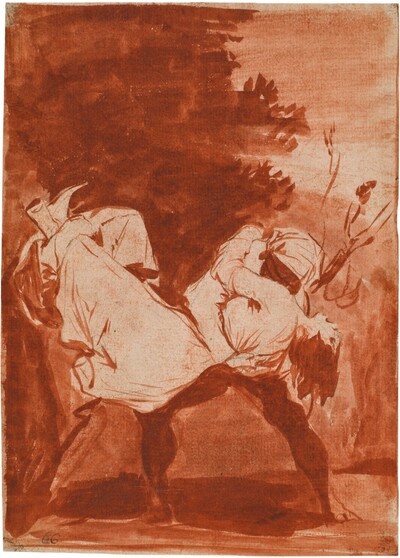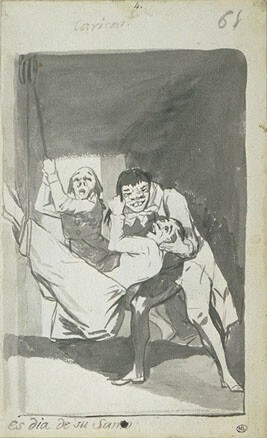- Cronología
- Ca. 1797 - 1799
- Dimensiones
- 218 x 153 mm
- Técnica y soporte
- Etching and burnished aquatint
- Reconocimiento de la autoría de Goya
- Undisputed work
- Ficha: realización/revisión
- 18 Nov 2010 / 29 May 2024
- Inventario
- 225
Qué se la llevaron! (at the bottom)
8 (in the upper right-hand corner)
See Francisco de Goya y Lucientes, Painter.
We have preserved a proof of status that must have been made prior to the handwriting that appears in pen and ink: that she is being taken away. In the print the verb tense was changed to That which was taken away. It should also be noted that, in the first proofs of the print run, the sentence ended in a full stop, which was later replaced by an exclamation mark.
There is a preparatory drawing in sanguine for this engraving in the Prado Museum. Furthermore, drawing no. 61 in Album B could be considered an antecedent for the work we are dealing with here.
A woman is being abducted by two figures, probably two men, whose faces we cannot see as they are wearing tunics that also cover their heads. One of them is holding her around the waist while the female figure puts her arm behind her neck to show resistance. The other grabs her legs at the ankles and restrains her. The woman's head is thrown back and her expression is one of suffering.
This is taking place at night, as can be seen from the dark sky achieved through the use of aquatint. The painter has left some lighter areas such as the central part of the woman's clothes and the heads of the two figures who are abducting her, on which the artist intends the viewer's attention to be focused.
In Ayala's manuscript it is said of this engraving that "the woman does not know how to keep, she belongs to the first one who catches her". In the Museo Nacional del Prado's manuscript it is stated that "the woman does not know how to keep, she belongs to the first one who catches her, and when she is beyond help they admire the fact that she has been taken away". Quite different, however, is the explanation given in the manuscript of the Biblioteca Nacional, which states that "an ecclesiastic who has an illicit love, looks for a scoundrel who helps him in the abduction of his beloved".
It is possible that this image has several meanings and that it refers to the love affairs that some members of the Church had despite their vow of chastity. But it is probably also a warning to women to look after their own dignity and not to put themselves in the hands of just anyone.
As in other engravings in this series and in some of the prints in The Disasters of War, Goya has depicted hooded figures completely covered and with their faces hidden, reminiscent of some of the figures in the paintings of Salvator Rosa (Naples, 1615-Rome, 1673).
The hooded figures and the depiction of the violence with which the women are treated represent a clear attempt by the Aragonese painter to approximate fear. In this image, Goya has investigated the sensations of the human being that are sometimes beyond the control of reason.
The plate is in poor condition ( National Chalcography, no. 179).
-
Goya. Gemälde Zeichnungen. Graphik. TapisserienKunsthalle BaselBasle1953from January 23th to April 12th 1953cat. 200
-
De grafiek van GoyaRijksmuseum RijksprentenkabinetAmsterdam1970from November 13th 1970 to January 17th 1971cat. 17
-
El arte de GoyaMuseo de Arte Occidental de TokioTokyo1971from 16th 1971 to January 23th 1972. Exhibited also at the Kyoto Municipal Museum of Art, January 29th to March 15th 1972.cat. 58
-
Goya. Das Zeitalter der Revolucionen. Kunst um 1800 (1980 – 1981)Hamburger KunsthalleHamburg1980cat. 23
-
Goya dans les collections suissesFundación Pierre GianaddaMartigny1982consultant editor Pierre Gassier. From June 12th to August 29th 1982cat. 44
-
Goya. La década de Los CaprichosMadrid1992organized by Real Academia de Bellas Artes de San Fernando sponsored by Fundación Central Hispano, Madrid, consultant editor Nigel Glendinnig. From October 26th 1992 to January 10th 1993cat. 18
-
GoyaNationalmuseumStockholm1994consultant editors Juan J. Luna and Görel Cavalli-Björkman. From October 7th 1994 to January 8th 1995cat. 54
-
Francisco de GoyaMuseo d'Arte ModernaLugano1996exhibition celebrated from September 22nd to November 17th.cat. 8, p.35
-
Francisco Goya. Sein leben im spiegel der graphik. Fuendetodos 1746-1828 Bordeaux. 1746-1996Galerie KornfeldBern1996from November 21st 1996 to January 1997cat. 14
-
Francisco Goya. Capricci, follie e disastri della guerraSan Donato Milanese2000Opere grafiche della Fondazione Antonio Mazzottacat. 8, p.19
-
Goya e la tradizione italianaFondazione Magnani RoccaMamiano di Traversetolo (Parma)2006consultant editors Fred Licht and Simona Tosini Pizzetti. From September 9th to December 3th 2006cat. 8, p.147
-
Goya. Opera graficaPinacoteca del Castello di San GiorgioLegnano2006exhibition celebrated from December 16th 2006 to April 1st 2007p.23
-
Goya et la modernitéPinacothèque de ParisParís2013from October 11st 2013 to March 16th 2014cat. 179
-
2022
-
Goya engravings and lithographs, vol. I y II.OxfordBruno Cassirer1964p.78, cat. 43
-
Vie et ouvre de Francisco de GoyaParísOffice du livre1970p.177, cat. 465
-
GoyaParísMinistère d’Etat-Affaires culturelles y Réunion des Musées Nationaux1970p.396, fig. 465
-
Goya, la década de los caprichos: dibujos y aguafuertesMadridReal Academia de Bellas Artes de San Fernando1992pp.29-32, cat. 17-19
-
Catálogo de las estampas de Goya en la Biblioteca NacionalMadridMinisterio de Educación y Cultura, Biblioteca Nacional1996p.78, cat. 96
-
El libro de los caprichos: dos siglos de interpretaciones (1799-1999). Catálogo de los dibujos, pruebas de estado, láminas de cobre y estampas de la primera ediciónMadridMuseo Nacional del Prado1999pp.88-91
-
ParísPinacoteca de París2013p. 245
-
Goya. In the Norton Simon MuseumPasadenaNorton Simon Museum2016pp. 42-75
-
Museo de Bellas Artes de Badajoz y Diputación de Badajoz2022p. 31


